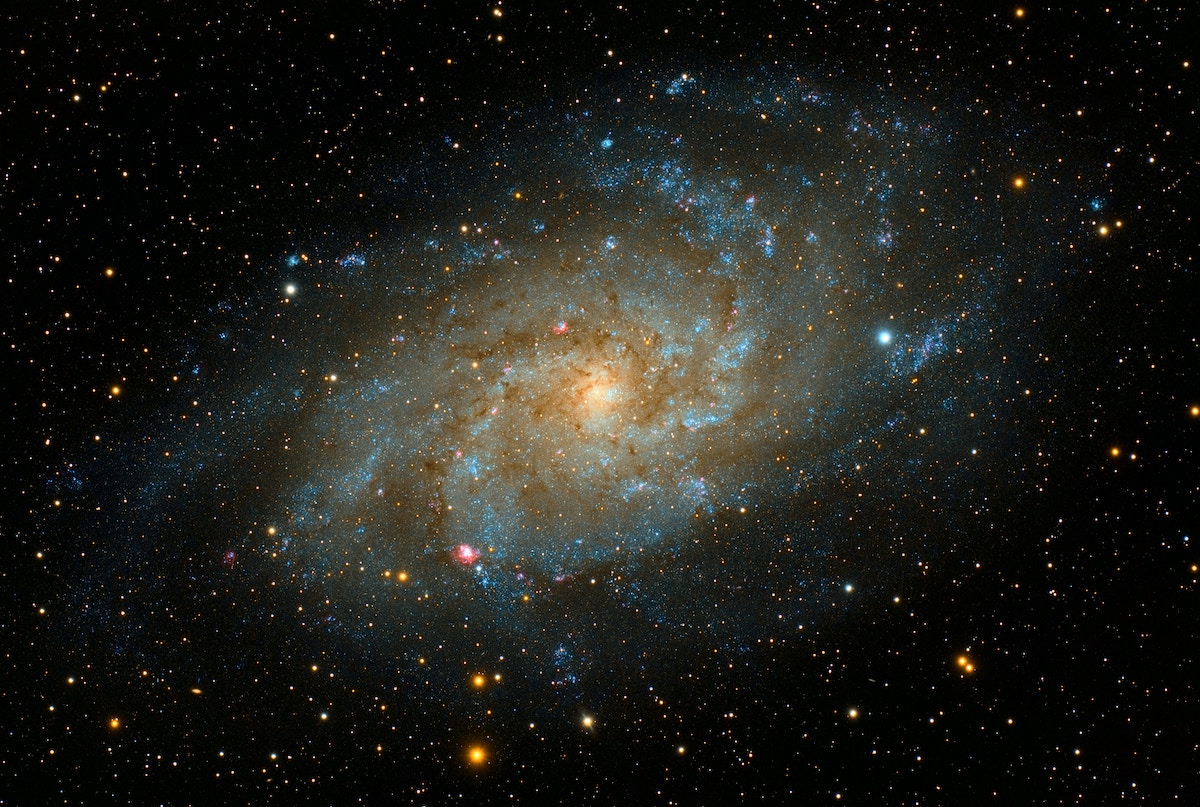In the depths of the universe, there exist billions of galaxies, each one a sprawling collection of stars, gas, and dust held together by the forces of gravity. From our own Milky Way to distant galaxies billions of light-years away, the study of galaxies has captivated astronomers and astrophysicists for centuries.
Galaxies come in a variety of shapes and sizes, ranging from small dwarf galaxies containing just a few million stars, to massive elliptical galaxies containing trillions of stars. The most common type of galaxy is the spiral galaxy, which features a flat, rotating disk of stars and gas, surrounded by a spherical halo of stars.
The stars within a galaxy are not distributed evenly, but are concentrated in regions known as star clusters. These clusters can contain anywhere from a few hundred to millions of stars, and are often the birthplace of new stars as gas and dust collapse under the force of gravity.
One of the most fascinating aspects of galaxies is the presence of supermassive black holes at their centers. These black holes, which can have masses billions of times greater than the sun, are thought to play a crucial role in the evolution of galaxies. As matter falls into the black hole, it releases intense radiation and energy, which can affect the surrounding gas and stars, and even trigger the formation of new stars.
In recent years, the study of galaxies has been revolutionized by advances in technology and instrumentation. Telescopes like the Hubble Space Telescope have provided stunning images of galaxies, allowing astronomers to study their structure and composition in unprecedented detail. Meanwhile, instruments like the Atacama Large Millimeter/submillimeter Array (ALMA) have allowed astronomers to observe the cold, dense gas clouds that give rise to new stars.
The study of galaxies has also shed light on some of the biggest mysteries of the universe, including the nature of dark matter and dark energy. Dark matter is an invisible form of matter that does not interact with light or other forms of electromagnetic radiation, but which is thought to make up the majority of the matter in the universe. Dark energy, on the other hand, is a mysterious force that is causing the expansion of the universe to accelerate.
In conclusion, galaxies are some of the most captivating objects in the universe, offering a glimpse into the vast and complex nature of space. From their diverse shapes and sizes to the mysteries of black holes and dark matter, the study of galaxies continues to be a source of fascination and discovery for astronomers and scientists around the world.
Types of Galaxies
Galaxies are vast systems of stars, gas, and dust, held together by gravity. They come in a variety of shapes and sizes, and astronomers have classified them into three main types: spiral, elliptical, and irregular.
Spiral galaxies are the most common type of galaxy, and they are characterized by a flat, rotating disk of stars and gas, surrounded by a spherical halo of stars. The spiral arms, which give these galaxies their characteristic spiral shape, contain young, hot stars, as well as clouds of gas and dust where new stars are forming. The center of the galaxy typically contains an active galactic nucleus, powered by a supermassive black hole.
Elliptical galaxies, on the other hand, are shaped like ellipsoids or ovals, and they lack the distinctive spiral arms of spiral galaxies. They contain mostly old, red stars, and little or no gas and dust. Elliptical galaxies are thought to have formed from the merging of several smaller galaxies, and they can range in size from dwarf galaxies to giant ellipticals containing trillions of stars.
Irregular galaxies are, as the name suggests, irregular in shape, and they do not fit neatly into the categories of spiral or elliptical galaxies. They can be chaotic in structure, with no clear symmetry or central bulge. Irregular galaxies can be further classified as either dwarf irregulars or magellanic irregulars, depending on their size and other characteristics.
Dwarf irregulars are small galaxies, typically containing less than a billion stars. They often have an irregular shape, with little or no organized structure. Magellanic irregulars are larger, and they are characterized by their clumpy, irregular structure, with dense regions of gas and dust where new stars are forming.
Overall, the classification of galaxies is an ongoing area of study, as astronomers continue to uncover new types and variations in galaxy structure and composition. Nevertheless, the three main types of spiral, elliptical, and irregular galaxies provide a useful framework for understanding the diversity of galaxies in the universe.
Key Features of Galaxies
Galaxies are vast systems of stars, gas, and dust that come in a variety of shapes and sizes. Despite their diversity, all galaxies share some common key features.
First and foremost, galaxies are held together by the force of gravity. The gravitational attraction between stars and other matter in the galaxy keeps them from flying off into space. The most massive component of most galaxies is a supermassive black hole at the center, which also plays a crucial role in regulating the motion of stars and gas.
Secondly, galaxies contain a wide range of stars, from massive, hot blue stars to small, cool red stars. These stars are often organized into clusters, which can contain anywhere from a few hundred to millions of stars. The stars within a galaxy are not distributed evenly, but rather are concentrated in certain regions, such as the center or the spiral arms.
Thirdly, galaxies contain gas and dust, which can be found in various forms. Molecular clouds of gas and dust are the sites where new stars are formed, while ionized gas emits light at specific wavelengths, providing astronomers with a way to study the chemical composition and physical conditions within a galaxy.
Fourthly, galaxies are not static, but rather are in a state of constant evolution. Stars are born, live out their lives, and eventually die, returning their matter to the interstellar medium from which new stars can form. Galaxies also grow and change through mergers with other galaxies, which can trigger the formation of new stars or the fueling of the supermassive black hole at the center.
Finally, galaxies exist within a larger cosmic framework, interacting with other galaxies, and being affected by the overall expansion and structure of the universe. The study of galaxies has provided insights into the fundamental nature of the universe, from the distribution of dark matter to the accelerating expansion driven by dark energy.
Famous Galaxies
Galaxies are fascinating objects in the universe, each with its own unique characteristics and features. Here are some of the most famous galaxies:
- Milky Way Galaxy: Our very own galaxy, the Milky Way, is a barred spiral galaxy containing hundreds of billions of stars, including our sun. It is thought to be about 13.5 billion years old and spans about 100,000 light-years.
- Andromeda Galaxy: Also known as Messier 31, the Andromeda Galaxy is a spiral galaxy located about 2.5 million light-years away from Earth. It is the closest galaxy to our own and is estimated to contain over a trillion stars.
- Sombrero Galaxy: Also known as Messier 104, the Sombrero Galaxy is an edge-on spiral galaxy located about 28 million light-years away from Earth. It is known for its distinctive shape, which resembles a sombrero hat.
- Whirlpool Galaxy: Also known as Messier 51, the Whirlpool Galaxy is a spiral galaxy located about 23 million light-years away from Earth. It is famous for its prominent spiral arms and its interaction with a smaller companion galaxy, which has caused extensive star formation.
- Large Magellanic Cloud: The Large Magellanic Cloud is a dwarf irregular galaxy located about 160,000 light-years away from Earth. It is a satellite galaxy of the Milky Way and is home to many star-forming regions, including the famous Tarantula Nebula.
- Triangulum Galaxy: Also known as Messier 33, the Triangulum Galaxy is a spiral galaxy located about 3 million light-years away from Earth. It is one of the most distant objects visible to the naked eye and is known for its high rate of star formation.
- Centaurus A: Also known as NGC 5128, Centaurus A is an elliptical galaxy located about 13 million light-years away from Earth. It is known for its prominent dust lane, which is thought to be the result of a merger with a smaller galaxy.
These are just a few examples of the many fascinating and famous galaxies in the universe. The study of galaxies continues to be a rich and exciting area of research for astronomers and astrophysicists, offering insights into the fundamental nature of the cosmos.
How can I see galaxies?
Observing galaxies can be a thrilling experience for amateur astronomers and stargazers. Here are some tips on how to see galaxies:
- Find a dark location: Light pollution can make it difficult to see faint objects such as galaxies. Therefore, it is important to find a location that is as far away from city lights as possible. The darker the sky, the better your chances of seeing galaxies.
- Use a telescope: Galaxies are often too faint to be seen with the naked eye, so a telescope is necessary. A good quality telescope with a large aperture can reveal many details in galaxies. The larger the aperture, the more light the telescope can gather, and the better the image will be.
- Use a star chart or app: Before you start observing, it’s important to know where to look. A star chart or app can help you locate galaxies in the sky. Some popular apps include SkySafari, Star Walk, and Stellarium.
- Observe during the right time of year: Different galaxies are visible at different times of the year, so it’s important to plan your observations accordingly. Some galaxies, like the Andromeda Galaxy, are visible all year round, while others, like the Whirlpool Galaxy, are only visible during certain months.
- Look for dark patches: Even with a telescope, galaxies may appear as faint, blurry patches of light. Look for areas in the sky that appear darker than their surroundings, as these may be areas where galaxies are located.
- Use filters: Certain filters can enhance the visibility of galaxies, especially in light-polluted areas. A narrowband filter, for example, can block out light pollution and enhance the contrast of galaxies.
- Be patient: Observing galaxies can take time and patience. It’s important to take breaks and let your eyes adjust to the darkness. The longer you observe, the more your eyes will adapt and the more detail you will be able to see.
In summary, observing galaxies requires a dark location, a telescope, and patience. With the right equipment and techniques, however, you can witness the beauty and complexity of these fascinating objects in the universe.

